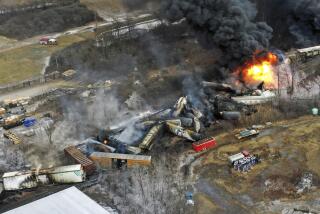Fatigue study may help put train hazards to rest
- Share via
New federal research shows that computer modeling can reliably predict when members of freight train crews have an increased risk of accident due to fatigue -- a finding that might help solve one of the most persistent safety problems in the railroad industry.
During the yearlong study, Federal Railroad Administration researchers were able to detect the point at which fatigue becomes hazardous by analyzing the often erratic and long work schedules of conductors, brake operators and locomotive engineers.
The findings could prompt the railroad industry to provide more rest for crew members between shifts, FRA officials said.
According to the study, tired crew members play a role in about 25% of all railroad accidents caused by human factors, such as poor judgment, miscommunication, inattentiveness and failure to follow procedures.
“Widespread acceptance by the railroad industry of the validated findings of this fatigue report could potentially lead to fewer serious train accidents,” said FRA Administrator Joseph H. Boardman.
Officials for the Assn. of American Railroads, the industry’s trade organization and lobbying arm, said they could not comment on the study because they had not had time to evaluate it. “We appreciate the FRA’s effort to throw light on the issue,” said Tom White, an association spokesman. “We need to work closely with labor on this. Some programs have not gotten anywhere in the past because of union opposition.”
Freight train engineers, conductors and brake operators have some of the most irregular and taxing work schedules in the transportation industry. They often put in 60 to 70 hours a week, and can be called to work at any time, which disrupts their sleep patterns and produces the equivalent of jet lag.
From 2001 to 2005, fatigue either caused or contributed to 1,473 of 5,892 human-factor related railroad accidents across the nation.
The number of mishaps related to crew failings has risen 50% to 60% since 1996, while the number of train accidents attributed to other causes, such as mechanical failure, has declined. FRA officials blame weary crew members for at least part of the increase.
Federal regulators identified fatigue as a top safety concern 20 years ago, and it has continued to haunt the railroad industry, especially the nation’s largest carriers.
Cost cutting by railroad companies, inadequate hiring and union members’ desire to maximize earnings have contributed.
Accident reports show that fatigue has caused some of the deadliest and costliest train accidents, including the 1990 head-on crash of two freight trains in Corona that killed four and caused $4.4 million in property damage.
In one of the latest such collisions, hundreds of people in and around Macdona, Texas, had to be evacuated in 2004 to avoid clouds of chlorine gas leaking from punctured tank cars. Three people died. As a result of that crash, the National Transportation Safety Board recommended in June that the FRA require railroads to base their scheduling decisions on scientific measures designed to reduce fatigue.
The FRA study, released last week, analyzed 1,400 train accidents and the work schedules of the crews involved for 30 days before each mishap.
The nation’s five largest railroads supplied the data, and researchers modified a mathematical model prepared by the Defense Department.
The FRA found a strong correlation between a crew’s estimated level of alertness and the likelihood of accidents.
Researchers said the severity of fatigue associated with some of the work schedules was equivalent to being awake for at least 21 hours.
FRA officials said their model could be adopted by railroads and labor unions to improve fatigue management plans.
“The hope is that the industry will now ... use this for crew scheduling decisions,” said railroad consultant William Keppen of Annapolis, Md.
Tom Pontolillo, director of regulatory affairs for the Brotherhood of Locomotive Engineers and Trainmen, said the FRA study would put the “onus on the industry” to do more about the fatigue problem.
He said his union might address rest requirements during contract negotiations or reintroduce federal legislation to increase time off for train crews -- bills that have been opposed by railroad companies.
“The FRA study will crank the heat up on the industry,” Pontolillo said. “I wouldn’t be surprised that this will lead to some efforts. The industry can no longer duck the issue.”
More to Read
Sign up for Essential California
The most important California stories and recommendations in your inbox every morning.
You may occasionally receive promotional content from the Los Angeles Times.














